Question
Outline the role of leptin in appetite control. [1]
▶️Answer/Explanation
Ans
a.acts on receptors in the hypothalamus/appetite centre ✔
b.inhibits appetite ✔
Question
Reproduction in eukaryotes can be sexual or asexual.
Describe the origin of eukaryotic cells according to the endosymbiotic theory.
Explain how hormones are used to control the human menstrual cycle.
Outline natural methods of cloning in some eukaryotes.
▶️Answer/Explanation
Markscheme
a. mitochondria and chloroplasts are similar to prokaryotes
b. «host» cell took in another cell by endocytosis/by engulfing «in a vesicle»
Allow “taking in” in place of “engulfing”
c. but did not digest the cell/kept the «ingested» cell alive
OR
symbiotic/mutualistic relationship «between engulfed and host cell»
d. chloroplasts and mitochondria were once independent/free-living «organisms»
e. DNA «loop» in chloroplast/mitochondrion
f. division/binary fission of chloroplast/mitochondrion
g. double membrane around chloroplast/mitochondrion
h. 70s ribosomes «in chloroplast/mitochondrion»
Award up to [2] for evidence from mpe to mph
[Max 4 Marks]
a. FSH stimulates the development of follicles
b. follicles produce estrogen
c. estrogen stimulates the repair of the uterus lining
d. estrogen stimulates LH secretion
e. LH causes/stimulates ovulation
f. LH causes/stimulates the development of the corpus luteum
g. corpus luteum secretes progesterone
h. progesterone causes/stimulates thickening of the uterus lining
OR
prepares uterine lining for implantation
OR
maintains the endometrium
i. progesterone/estrogen inhibits the secretion of LH/FSH
j. falling progesterone levels at the end of the cycle allow FSH production/menstruation
k. negative/positive feedback «control» described correctly
l. LH/FSH are pituitary hormones
[Max 8 Marks]
a. clones are genetically identical organisms
OR
group of cells derived from a single parent cell
b. asexual reproduction in plants such as tubers/runners/bulbs
Allow other verifiable examples of plants
c. common in non-vertebrates such as budding in hydra
Allow other verifiable examples of invertebrates
d. budding in yeast/fungi
Allow other verifiable examples of fungi
e. identical twins «in humans» are clones because they originate from
the same cell
Question
The electron micrograph shows the structures in an exocrine gland cell of the pancreas.
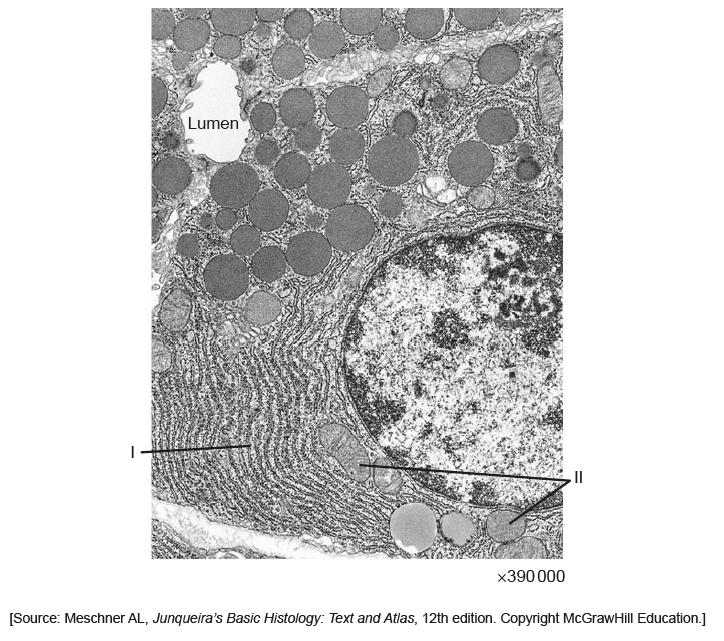
Glands are organs that secrete and release particular chemical substances. Melatonin is an important hormone secreted in the pineal gland in the brain. Describe its role in mammals.
State the principal product of this cell.
Using the table, identify the organelles labelled I and II on the electron micrograph with their principal role.

▶️Answer/Explanation
Markscheme
a. controls circadian rhythms/biological clocks «in mammals»
b. production is controlled by amount of light detected by the retina
c. high production/secretion in the dark
OR
no production/secretion in the day
OR
production/secretion is directly proportional to night time duration
d. affects «seasonal» reproduction/sleep-wake cycles/jet lag
«digestive» enzymes
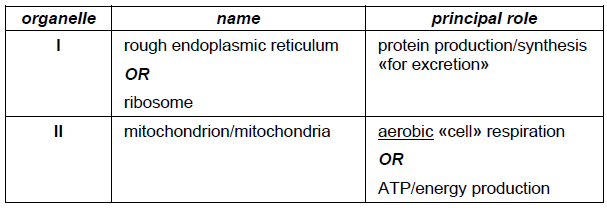
Question
James Beard, a famous chef, once said “Food is our common ground, a universal experience.”
Explain how the small intestine moves, digests and absorbs food.
Distinguish between the structures of the different types of fatty acids in food.
Outline how leptin controls appetite.
▶️Answer/Explanation
Markscheme
a. contraction of muscle «layers»/peristalsis helps move food
OR
circular muscle contraction prevents backward movement of food
OR
longitudinal muscle contraction moves food along gut
b. peristalsis/muscle contractions mix food with intestinal enzymes
c. enzymes digest macromolecules into monomers
Accept an example for mp c
d. pancreatic enzymes/amylase/lipase/endopeptidase «chemically» digest food in«lumen of» small intestine
e. «pancreatic» amylase digests starch
OR
lipases digest lipids/fats/triglycerides
OR
endopeptidases/dipeptidases digest proteins/polypeptides
f. bile/bicarbonate secreted into the small intestine creates favorable pH for enzymes
OR
bile emulsifies fat
g. some final digestion into monomers is associated with epithelial cells/epithelium «of small intestine»
h. mucosa layer/inside surface/lining of small intestine contains villi/finger-like projections
i. villi/microvilli increase surface area for better absorption
j. villi absorb products of digestion/monomers/mineral «ions»/vitamins
k. glucose/amino acids enter blood «capillaries»
OR
lipids enter lymph vessels/lacteals
l. absorption involves active transport/diffusion/facilitated diffusion
m. different nutrients are absorbed by different transport mechanisms
a. fatty acids can be saturated or unsaturated
b. unsaturated can be monounsaturated or polyunsaturated
c. saturated fats have no double bonds/have maximum number of hydrogen atoms
OR
unsaturated fatty acids have «at least one» double C=C bond
OR
polyunsaturated fatty acids have more than one double bond / OWTTE
d. cis-form has hydrogen atoms on same side of carbon double bond
OR
cis-form has bend at carbon double bond
e. trans-form has hydrogens on opposite sides of carbon double bond
OR
trans-form makes a straight carbon chain
f. length of hydrocarbon chain can vary
OR
position/number of carbon double bonds can vary
Accept labeled diagrams that illustrate these marking points
a. leptin suppresses/inhibits appetite
b. is secreted by adipose tissue/fat «storage» tissue
c. level is controlled by amount of adipose tissue/«ongoing» food intake
d. leptin targets cells in hypothalamus/appetite control centre in brain
e. causes hypothalamus/control centre in brain to inhibit appetite
f. if amount of adipose tissue increases, blood leptin concentration rises
Question
Diabetes is often associated with the failure of the β (beta) cells in the pancreas, but it is unclear what actually causes this failure. FoxO1 is a protein which acts as a transcription factor to regulate the expression of genes involved in cell growth. FoxO1 also regulates increase in number and differentiation in cells such as pancreatic β cells.
A study was conducted using mice lacking the gene for FoxO1 in β cells (IKO) as well as normal (control) mice. Blood glucose levels after fasting were compared for four groups of mice: young (3 months old) male mice, young (3 months old) female mice, older females (who have had several pregnancies) and aging males (16–20 months).
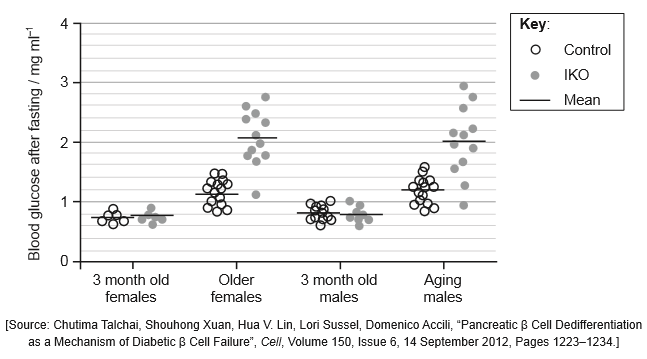
The levels of pancreatic hormones and β cell mass in older female control mice and older female IKO mice lacking FoxO1 were then investigated.
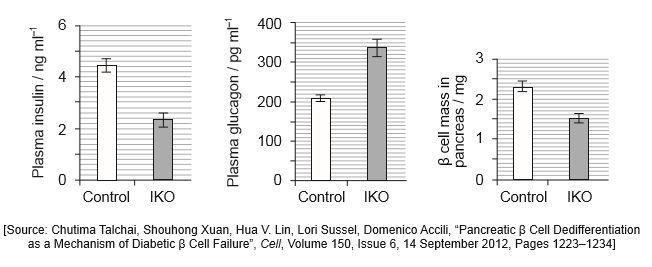
Compare blood glucose levels after fasting in young control mice and young IKO mice without FoxO1.
Estimate the difference between mean blood glucose levels in control and IKO older female mice.
……………..mg ml–1
Aging and having pregnancies are considered to be physiological stresses. Deduce the effect of stress on blood glucose levels.
Outline the relationship between blood glucose levels after fasting and lack of FoxO1 in the mice studied.
Calculate the percentage difference in β cell mass of the IKO mice compared to the control mice.
State the correlation between lack of FoxO1 and pancreatic hormones in mice.
Referring to the functions of insulin and glucagon, suggest how the differences in hormone levels help to explain the blood glucose levels.
▶️Answer/Explanation
Markscheme
a. similar/same/nearly same (means)/very small difference/both at a low level;
b. means/averages (all) close to 0.8 mg ml–1;
c. difference not (statistically) significant;
d. similar/same/nearly same range of values/spread of data;
All marking points are comparisons between control and IKO mice. Do not award marks for comparisons between male and female mice.
1 mg ml–1 (accept values between 0.8 – 1)
a. stress causes increase in (mean) blood glucose/sugar;
b. older mice/males/females / aging mice show the increase;
Reject answers that only compare control and IKO mice or only compare male and female mice.
a. in young mice/3 month old mice lack of FoxO1/IKO/fewer beta cells does not affect/has little effect on blood glucose/sugar;
b. in older females/aging males blood glucose/sugar (much) higher with lack of FoxO1/IKO/fewer beta cells;
Award [1] for an answer:
a. accept either 35 / 34.8 / 34.78 (this answer may be expressed as negative) OR 53 / 53.3 / 53.33;
Do not award the mark if more than two decimal places shown or if the answer is incorrectly rounded up or down.
Award [1] for working, accepting any of the following:
OR other credible alternatives for working;
lack of FoxO1 (correlates) with low/decreased insulin and high/increased glucagon levels.
a. insulin used to take up/reduce glucose levels (after eating/when blood glucose levels high);
b. decrease in insulin in FoxO1 lacking/IKO mice would cause increase in glucose levels (as less is removed);
c. glucagon (used to convert stored carbohydrate to glucose) to increase glucose levels;
d. increase in glucagon (as seen in second graph, where IKO level higher than control) would mean more glucose added to blood/increase in glucose levels (on first graph);
e. (on first graph) see older/stressed/adult female mice with much higher glucose levels than young mice;
Question
The diagram shows the molecular structure of the amino acid leucine.
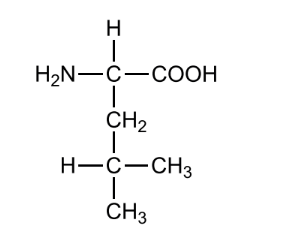
(a) Draw a circle on the diagram to enclose the carboxyl group. [1]
(b) State one protein that acts as a hormone. [1]
(c) Explain how enzymes are used in the preparation of milk suitable for individuals who are lactose intolerant. [2]
▶️Answer/Explanation
a
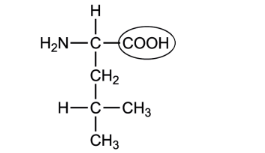
b insulin/glucagon/ADH/oxytocin/leptin / other verified example;
c a. the enzyme lactase acts on lactose;
b. the enzymes are immobilised / are bound to alginate beads;
c. (pouring milk over the immobilised enzymes) causes lactose to be hydrolysed/broken down into monosaccharides/glucose and galactose;
